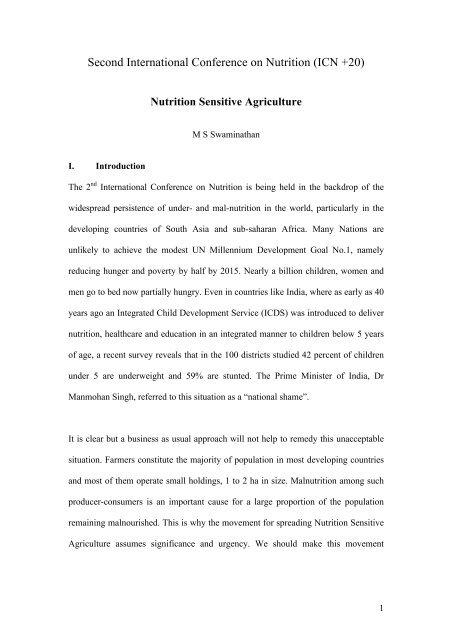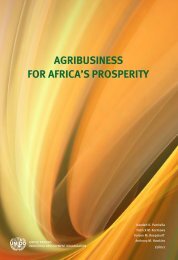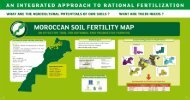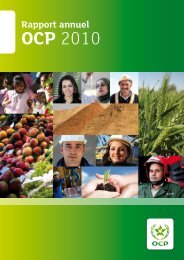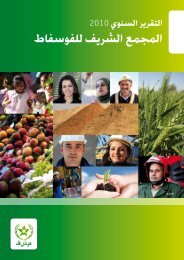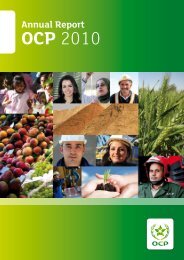Second International Conference on Nutrition (ICN +20) - Global ...
Second International Conference on Nutrition (ICN +20) - Global ...
Second International Conference on Nutrition (ICN +20) - Global ...
You also want an ePaper? Increase the reach of your titles
YUMPU automatically turns print PDFs into web optimized ePapers that Google loves.
<str<strong>on</strong>g>Sec<strong>on</strong>d</str<strong>on</strong>g> <str<strong>on</strong>g>Internati<strong>on</strong>al</str<strong>on</strong>g> <str<strong>on</strong>g>C<strong>on</strong>ference</str<strong>on</strong>g> <strong>on</strong> Nutriti<strong>on</strong> (<strong>ICN</strong> <strong>+20</strong>)<br />
I. Introducti<strong>on</strong><br />
Nutriti<strong>on</strong> Sensitive Agriculture<br />
M S Swaminathan<br />
The 2 nd <str<strong>on</strong>g>Internati<strong>on</strong>al</str<strong>on</strong>g> <str<strong>on</strong>g>C<strong>on</strong>ference</str<strong>on</strong>g> <strong>on</strong> Nutriti<strong>on</strong> is being held in the backdrop of the<br />
widespread persistence of under- and mal-nutriti<strong>on</strong> in the world, particularly in the<br />
developing countries of South Asia and sub-saharan Africa. Many Nati<strong>on</strong>s are<br />
unlikely to achieve the modest UN Millennium Development Goal No.1, namely<br />
reducing hunger and poverty by half by 2015. Nearly a billi<strong>on</strong> children, women and<br />
men go to bed now partially hungry. Even in countries like India, where as early as 40<br />
years ago an Integrated Child Development Service (ICDS) was introduced to deliver<br />
nutriti<strong>on</strong>, healthcare and educati<strong>on</strong> in an integrated manner to children below 5 years<br />
of age, a recent survey reveals that in the 100 districts studied 42 percent of children<br />
under 5 are underweight and 59% are stunted. The Prime Minister of India, Dr<br />
Manmohan Singh, referred to this situati<strong>on</strong> as a “nati<strong>on</strong>al shame”.<br />
It is clear but a business as usual approach will not help to remedy this unacceptable<br />
situati<strong>on</strong>. Farmers c<strong>on</strong>stitute the majority of populati<strong>on</strong> in most developing countries<br />
and most of them operate small holdings, 1 to 2 ha in size. Malnutriti<strong>on</strong> am<strong>on</strong>g such<br />
producer-c<strong>on</strong>sumers is an important cause for a large proporti<strong>on</strong> of the populati<strong>on</strong><br />
remaining malnourished. This is why the movement for spreading Nutriti<strong>on</strong> Sensitive<br />
Agriculture assumes significance and urgency. We should make this movement<br />
1
envir<strong>on</strong>mentally, ec<strong>on</strong>omically and socially sustainable and implementable. This<br />
paper provides a road map for this purpose.<br />
II. Definiti<strong>on</strong>s<br />
1. Agriculture : Agriculture is a professi<strong>on</strong> based <strong>on</strong> crop and animal husbandry,<br />
forestry and agro-forestry, capture and culture fisheries and agro-processing,<br />
practiced either separately or in combinati<strong>on</strong> in the form of integrated farming<br />
systems, such as crop-livestock, crop-fish, crop-livestock-fish, tree-species<br />
and annual crops (agro-forestry) and a wide range of <strong>on</strong>-farm and off-farm<br />
occupati<strong>on</strong>s. In most developing countries, agriculture is both a way of life<br />
and the principal means to livelihood. Unlike in industrialised countries, it is<br />
not just a commodity producing enterprise, but is the backb<strong>on</strong>e of the<br />
livelihood security system of a high proporti<strong>on</strong> of the populati<strong>on</strong> in a majority<br />
of developing countries in Asia, Africa and Latin America. Small scale family<br />
farming is generally the rule in developing countries, while farming generally<br />
takes the form of large agri-business enterprises in industrialised countries. In<br />
developed nati<strong>on</strong>s, <strong>on</strong>ly 2 to 3 % of the populati<strong>on</strong> are classified as farmers, in<br />
c<strong>on</strong>trast to 50 to 70 % of the populati<strong>on</strong> in Sub-saharan Africa and South Asia.<br />
2. Nutriti<strong>on</strong> Security involves physical, ec<strong>on</strong>omic and social access to balanced<br />
diet (the needed macro and micro-nutrients), clean drinking water, sanitati<strong>on</strong>,<br />
primary healthcare and nutriti<strong>on</strong>al literacy.<br />
3. Nutriti<strong>on</strong>-sensitive Agriculture : Nutriti<strong>on</strong> sensitive farming involves the<br />
design and adopti<strong>on</strong> of cropping and farming systems which can provide<br />
2
agricultural remedies to the prevailing nutriti<strong>on</strong>al maladies. Nutriti<strong>on</strong>al<br />
maladies may take the following forms<br />
• Protein-energy under or mal-nutriti<strong>on</strong>, primarily caused by<br />
poverty-induced lack of purchasing power<br />
• Hidden hunger arising from the deficiency of micro-nutrients in<br />
the diet, such as deficiency of ir<strong>on</strong>, iodine, zinc, Vitamin A,<br />
Vitamin B12, etc<br />
• Transient hunger arising from either natural calamities or civil<br />
disturbances including ethnic c<strong>on</strong>flicts.<br />
A Nutriti<strong>on</strong>-sensitive agricultural system should be capable of addressing the above<br />
forms of nutriti<strong>on</strong> insecurity at the household, community and nati<strong>on</strong>al levels.<br />
III. Approaches to mainstreaming the nutriti<strong>on</strong> dimensi<strong>on</strong> in agriculture<br />
To begin with, the following systems of farm research should incorporate<br />
nutriti<strong>on</strong>al criteria<br />
a) Cropping System Research (CSR), which involves crop-crop rotati<strong>on</strong>. A<br />
cereal-legume rotati<strong>on</strong> will provide both proteins to human beings and<br />
nitrogen to the soil. Hidden hunger in the soil leads to hidden hunger<br />
am<strong>on</strong>g human beings. A combinati<strong>on</strong> of millet like Eleucine coracana and<br />
Moringa can provide all the macro- and micro-nutrients needed by the<br />
body.<br />
3
) Farming System Research (FSR), which will involve crop-livestock-fish<br />
integrati<strong>on</strong> in different combinati<strong>on</strong>s. FSR provides unique opportunities<br />
for promoting nutriti<strong>on</strong> sensitive agriculture, since the introducti<strong>on</strong> of<br />
dairy, poultry, fish and other sources of animal protan in the diet al<strong>on</strong>g<br />
with the basic staples will help in providing a balanced diet.<br />
c) Coastal System Research (CSR) CSR involves integrated planning for<br />
the landward and seaward sides of the shore line. It is based <strong>on</strong> c<strong>on</strong>current<br />
attenti<strong>on</strong> to coastal forestry and agro-forestry, as well as to capture and<br />
culture fisheries. The Sea Water Farming project of MSSRF promotes<br />
integrated agri-aqua farming. Halophytes like Salicornia, Atriplex, brown<br />
algae, etc., are important sources of nutriti<strong>on</strong> and c<strong>on</strong>stitute good human<br />
food as well as animal feed. Rice varieties with high salinity tolerance can<br />
also be planted. Sea water c<strong>on</strong>stitutes 97% of the global water resource. It<br />
is hence an important social asset. Sea Water Farming, rooted in<br />
nutriti<strong>on</strong>al principles, will help to enhance the nutriti<strong>on</strong> security of<br />
coastal communities.<br />
d) Rural System Research (RSR) RSR takes a holistic view of rural<br />
livelihoods – both <strong>on</strong>-farm and off-farm (Swaminathan, 1988). The major<br />
aim of RSR is to ensure work and income security to family farmers<br />
operating small holdings. Improving the productivity and profitability of<br />
small holdings in an envir<strong>on</strong>mentally sustainable manner, and generating<br />
opportunities for agro-processing and value-additi<strong>on</strong> to primary products,<br />
as well as creating awareness for productive employment in the services<br />
sector are the goals of RSR. Thus RSR will help to improve ec<strong>on</strong>omic<br />
access to food and provide some insulati<strong>on</strong> against price volatility.<br />
4
e) How can Cropping System, Farming System, Coastal System and Rural<br />
System research help to promote nutriti<strong>on</strong> sensitive agriculture?<br />
IV. Designing Nutriti<strong>on</strong> Sensitive Systems of Farming and their<br />
Disseminati<strong>on</strong><br />
For ensuring adequate nutriti<strong>on</strong> of the right quality to an individual, a life-cycle<br />
approach will have to be adopted. Starting with pregnant women, the life cycle<br />
approach extends upto old and infirm pers<strong>on</strong>s. Maternal and foetal under- and mal-<br />
nutriti<strong>on</strong> leads to the birth of babies characterised by low birth weight (LBW). Such<br />
LBW babies suffer from many handicaps in later life including impaired cognitive<br />
ability. A food based approach to overcoming malnutriti<strong>on</strong> at every stage in the life<br />
cycle will call for a carefully planned choice of crops. The following steps will be<br />
involved in this process:<br />
a) C<strong>on</strong>duct a survey in the village of the nutriti<strong>on</strong>al problems which need<br />
attenti<strong>on</strong>, as for example ir<strong>on</strong> deficiency anaemia, blindness arising from<br />
the deficiency of Vitamin-A, goitre resulting from iodine deficiency and<br />
also health problems arising from the deficiency of essential amino acids<br />
like lysine.<br />
b) Identify crops which can provide the needed nutrients, as shown in the<br />
following figure and table<br />
5
Nutriti<strong>on</strong>al Malady and Horticultural Remedy<br />
Some Examples<br />
Malady:<br />
Vitamins:<br />
Vitamin A<br />
Vitamin B Complex<br />
Vitamin C<br />
Minerals<br />
Ir<strong>on</strong><br />
Iodine<br />
Zinc<br />
Copper<br />
Remedy:<br />
Rape Leaves<br />
Cauliflower<br />
Amaranth<br />
Drumstick leaves<br />
Spinach<br />
Parsley<br />
Turnip Greens<br />
Carrot<br />
Tapioca chips<br />
Sweet Potato<br />
Yam<br />
Radish<br />
Combating Hidden Hunger /<br />
Moringa oleifera<br />
Annual Moringa<br />
Variety developed<br />
at the Tamil Nadu<br />
Agricultural<br />
University<br />
Moringa and Millets provide all the macroand<br />
micro-nutrients required by the body<br />
Source: Lost Crops of Africa, Vegetables, Volume II, 2006, Nati<strong>on</strong>al Research Council of the<br />
Nati<strong>on</strong>al Academies, The Nati<strong>on</strong>al Academies Press, Washingt<strong>on</strong>, D.C.<br />
A crop like Quality Protein Maize (QPM) can provide the needed lysine rich<br />
protein.<br />
c) Based <strong>on</strong> the survey informati<strong>on</strong> and the food based opportunities for<br />
overcoming the prevailing malnutriti<strong>on</strong> problems, help farm families to<br />
incorporate the nutriti<strong>on</strong>al dimensi<strong>on</strong> in their cropping / farming system.<br />
6
To undertake such tasks, it will be useful to promote the formati<strong>on</strong> of a Farmers’<br />
Council for Nutriti<strong>on</strong> Security in each agro-ecological regi<strong>on</strong>, comprising of both<br />
men and women farmers and a Home Science graduate trained in Nutriti<strong>on</strong>. Such a<br />
Council can undertake the task of spreading nutriti<strong>on</strong> literacy am<strong>on</strong>g farm families,<br />
and at the same time help in the adopti<strong>on</strong> of cropping and farming systems which<br />
address the nutriti<strong>on</strong>al challenges faced by local families. Such local level Farmers’<br />
Councils can join together and form a Nati<strong>on</strong>al Council of Farmers for Nutriti<strong>on</strong><br />
Security at the country level. Ultimately, with the help of FAO, WHO, UNICEF,<br />
IFAD, WFP and UNDP, a <strong>Global</strong> Council of farmers for Nutriti<strong>on</strong> Security can be<br />
established.<br />
C<strong>on</strong>certed efforts are now in progress to integrate nutriti<strong>on</strong>al factors in crop<br />
improvement research. For example, CGIAR’s Harvest Plus programme aims to<br />
enrich staple grains with micr<strong>on</strong>utrients like Fe, Vitamin A, Zinc, etc as shown in<br />
Annexure 1.<br />
Beta carotene rich Sweet potato is another easily available source of Vitamin-A.<br />
Children like mashed sweet potato and the crop grows well under a wide range of<br />
c<strong>on</strong>diti<strong>on</strong>s. Many of the major and minor millets are rich in protein. Instead of<br />
referring to them as coarse cereals, they should be classified as “Nutri-cereals”.<br />
Such minor millets are also more climate resilient and hence will become important in<br />
an era of climate change.<br />
Public policy measures should help to enlarge the food basket so as to add nutriti<strong>on</strong>-<br />
rich grains in daily c<strong>on</strong>sumpti<strong>on</strong>. An important step in this directi<strong>on</strong> is being taken in<br />
7
India, where the Food Security Act recently introduced in Parliament, provides for the<br />
supply of highly subsidised grains to all individuals requiring social protecti<strong>on</strong> for<br />
meeting their dietary needs. In additi<strong>on</strong> to wheat and rice, the Act provides for the<br />
supply of nutri-cereals to all needing social protecti<strong>on</strong>, at the rate of Rupee <strong>on</strong>e per kg<br />
(1 US Dollar : about 50 Indian rupees). It is hoped that such a step will enthuse<br />
farmers to take to the cultivati<strong>on</strong> of a wide range of locally adapted millets as well as<br />
to crops like Quality Protein Maize.<br />
Nutriti<strong>on</strong> rich crop varieties are also being produced through the recombinant DNA<br />
technology (genetic modificati<strong>on</strong>). There are public c<strong>on</strong>cerns about GMOs and until<br />
such c<strong>on</strong>cerns are adequately addressed, genetically fortified crops bred by Mendelian<br />
methods or by Molecular Marker-Assisted Selecti<strong>on</strong> (MAS) could be used for<br />
overcoming the deficiency of micro-nutrients in the diet. A nati<strong>on</strong>al food cum<br />
genetic enrichment method will be ideal.<br />
In additi<strong>on</strong> to local level Farmers’ Councils for Nutriti<strong>on</strong> Security, a woman and man<br />
selected by local communities can be trained as Community Hunger Fighters in<br />
every village. Such a programme initiated by the M S Swaminathan Research<br />
Foundati<strong>on</strong> in the hunger hot spot area of Koraput in the State of Odisha, involves the<br />
training of a cadre of young women and men in providing agricultural remedies to the<br />
nutriti<strong>on</strong>al deficiencies prevailing in the area. The soluti<strong>on</strong>s suggested by the<br />
Community Hunger Fighters to the malnutriti<strong>on</strong> problems of the area should be<br />
implementable, affordable replicable and sustainable.<br />
8
For spreading Nutriti<strong>on</strong> Sensitive Agriculture, a decentralised approach will be<br />
needed. The CSR, FSR and Coastal System Research programmes should be tailored<br />
to the prevailing agro-climatic, agro-ecological and socio-ec<strong>on</strong>omic c<strong>on</strong>diti<strong>on</strong>s. The<br />
n<strong>on</strong>-farm comp<strong>on</strong>ent of RSR should be based <strong>on</strong> a market-driven approach. Above all,<br />
women should play a lead role in all issues relating to balanced diet and good<br />
nutriti<strong>on</strong> since they are generally incharge of household food security. Also, they play<br />
a lead role in raising food crops, cultivating vegetables and attending to post-harvest<br />
technology.<br />
V. Summing-up<br />
2014 has been declared as the Year of the Family Farmer by the United Nati<strong>on</strong>s.<br />
After careful preparati<strong>on</strong> during 2012-13, a global programme can be launched during<br />
2014 <strong>on</strong> spreading the message and methods of Nutriti<strong>on</strong> Sensitive Agriculture. All<br />
over the world, Farmers’ Councils for Nutriti<strong>on</strong> Security can be organised. Such<br />
Councils with the help of Community Hunger Fighters can become the flagship for a<br />
Nutriti<strong>on</strong> Secure World.<br />
9
VITAMIN A CASSAVA<br />
Release Date: 2011<br />
Genetic Fortificati<strong>on</strong><br />
Annexure I<br />
Cassava is a robust crop able to withstand disease, drought, and pests. It grows well<br />
<strong>on</strong> marginal soils and is grown where both poverty and malnutriti<strong>on</strong> are widespread.<br />
Nutrient: Provitamin A<br />
Baseline: 0 parts per milli<strong>on</strong><br />
target: 15 parts per milli<strong>on</strong><br />
Agr<strong>on</strong>omic traits: High yielding, virus resistance<br />
target Countries: Nigeria, Democratic Republic of C<strong>on</strong>go (DRC)<br />
Deficiency Rates: 30% of children under 5 in Nigeria and 61% of children under 5 in<br />
DRC are estimated to be vitamin A deficient.<br />
Average C<strong>on</strong>sumpti<strong>on</strong> (adults): 600 grams/capita/day<br />
Vitamin A Cassava Can Provide: 50% of the mean daily vitamin A needs of adult<br />
women.<br />
VITAMIN A MAIZE<br />
Release Date: 2012<br />
Maize is the most important cereal food crop in Sub-Saharan Africa and Latin<br />
America.<br />
Nutrient: Provitamin A<br />
Baseline: 0 parts per milli<strong>on</strong><br />
target: 15 parts per milli<strong>on</strong><br />
Agr<strong>on</strong>omic traits: High yielding, disease and virus resistance, drought tolerance<br />
Target Country: Zambia<br />
Deficiency Rates: 54% of children under 5 are estimated to be vitamin A deficient.<br />
Average C<strong>on</strong>sumpti<strong>on</strong> (adults): 300 grams/capita/day<br />
Vitamin A Maize Can Provide: 50% of the mean daily vitamin A needs of adult<br />
women.<br />
ZINC RICE<br />
Release Date: 2013<br />
Rice is the staple food for more than half the world’s populati<strong>on</strong>. In many Asian<br />
countries, rice provides up to 80 percent of the energy intake of the poor.<br />
Nutrient: Zinc<br />
Baseline: 16 parts per milli<strong>on</strong><br />
Target: 24 parts per milli<strong>on</strong><br />
Agr<strong>on</strong>omic traits: High yielding, disease and pest resistance<br />
target Countries: Bangladesh, India<br />
Deficiency Rates: Approximately 44% of children under 5 in both Bangladesh and<br />
India are at risk of zinc deficiency.<br />
10
Average C<strong>on</strong>sumpti<strong>on</strong> (adults): 400 grams/capita/day<br />
Zinc Rice Can Provide: 40% of the mean daily zinc needs of adult women.<br />
11
IRON PEARL MILLET<br />
Release Date: 2012<br />
Pearl millet is grown in harsh envir<strong>on</strong>ments in the arid and semi-arid regi<strong>on</strong>s of Asia<br />
and Africa providing both energy and nutriti<strong>on</strong> to poor farming communities.<br />
Nutrient: Ir<strong>on</strong><br />
Baseline: 47 parts per milli<strong>on</strong><br />
target: 77 parts per milli<strong>on</strong><br />
Agr<strong>on</strong>omic traits: High yielding, mildew resistance, drought tolerance.<br />
target Country: India<br />
Deficiency Rates: 74% of children under 5 and 52% of n<strong>on</strong>-pregnant women are<br />
anemic. In western India, where pearl millet is a staple food, an estimated 66% of<br />
children under 5 are anemic.<br />
Average C<strong>on</strong>sumpti<strong>on</strong> (adults): 300 grams/capita/day<br />
Ir<strong>on</strong> Pearl Millet Can Provide: 30% of the mean daily ir<strong>on</strong> needs (and 40% of zinc<br />
needs) of adult women.<br />
ZINC WHEAT<br />
Release Date: 2013<br />
Wheat is the sec<strong>on</strong>d most c<strong>on</strong>sumed cereal in Asia, after rice, but is grown<br />
worldwide; wheat is sown <strong>on</strong> more than 200 milli<strong>on</strong> hectares of developing country<br />
farmland.<br />
Nutrient: Zinc<br />
Baseline: 25 parts per milli<strong>on</strong><br />
target: 33 parts per milli<strong>on</strong><br />
Agr<strong>on</strong>omic traits: High yielding, disease resistance<br />
Target Countries: India, Pakistan<br />
Deficiency Rates: 44% of children under 5 in India and 37% in Pakistan are at risk of<br />
zinc deficiency.<br />
Average C<strong>on</strong>sumpti<strong>on</strong> (adults): 350 grams/capita/day<br />
Zinc Wheat Can Provide: 40% of the mean daily zinc needs of adult women.<br />
IRON BEAN<br />
Release Date: 2012<br />
The comm<strong>on</strong> bean is am<strong>on</strong>g the world’s most important food legumes. Beans are an<br />
important<br />
part of the diet for milli<strong>on</strong>s of people in Africa and Central and South America.<br />
Nutrient: Ir<strong>on</strong><br />
Baseline: 50 parts per milli<strong>on</strong><br />
Target: 94 parts per milli<strong>on</strong><br />
Agr<strong>on</strong>omic traits: High yielding, virus resistance, heat and drought tolerance<br />
Target Countries: Rwanda, Democratic Republic of C<strong>on</strong>go (DRC)<br />
Deficiency Rates: In Rwanda, an estimated 56% of children under 5 and 33% of n<strong>on</strong>pregnant<br />
women are anemic. In DRC, an estimated 71% of children under 5 and 53%<br />
of n<strong>on</strong>-pregnant women are anemic.<br />
Average C<strong>on</strong>sumpti<strong>on</strong> (adults): 250 grams/capita/day<br />
Ir<strong>on</strong> Bean Can Provide: 30% of the mean daily<br />
12
Nutriti<strong>on</strong> Sensitive Agriculture<br />
Possible Collaborators and C<strong>on</strong>tributors<br />
1. Dr Dennis Garrity, DG, World Agro-forestry Centre, Nairobi<br />
(d.garrity@cgiar.org)<br />
2. Dr Miguel Altieri, Professor of Agroecology, University of California, Berkeley<br />
(agroeco3@berkeley.edu)<br />
3. Dr Renato S Maluf and Dr Ana F<strong>on</strong>seca (Brazil)<br />
(renato.maluf@terra.com.br)<br />
4. Dr (Ms) Sheela Ramachandran, VC, Avinashilingam University<br />
(vc@avinuty.ac.in)<br />
5. Dr Parviz Koohafkan, FAO, Rome (Parviz.koohafkan@fao.org;<br />
parvizkoohafkan@gmail.com)<br />
6. Dr B Sesikeran, Director, Nati<strong>on</strong>al Institute of Nutriti<strong>on</strong> (sesikeran@gmail.com)<br />
7. Director General of IRRI, CIMMYT and IFPRI<br />
13


